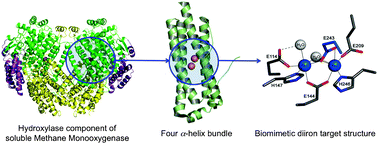Current challenges of modeling diironenzyme active sites for dioxygenactivation by biomimetic synthetic complexes
Abstract
This tutorial review describes recent progress in modeling the active sites of

* Corresponding authors
a
Department of Chemistry, Massachusetts Institute of Technology, Cambridge, USA
E-mail:
erwin.reisner@manchester.ac.uk, lippard@mit.edu
b School of Chemistry, The University of Manchester, Oxford Road, Manchester M13 9PL, UK
This tutorial review describes recent progress in modeling the active sites of

 Please wait while we load your content...
Something went wrong. Try again?
Please wait while we load your content...
Something went wrong. Try again?
S. Friedle, E. Reisner and S. J. Lippard, Chem. Soc. Rev., 2010, 39, 2768 DOI: 10.1039/C003079C
To request permission to reproduce material from this article, please go to the Copyright Clearance Center request page.
If you are an author contributing to an RSC publication, you do not need to request permission provided correct acknowledgement is given.
If you are the author of this article, you do not need to request permission to reproduce figures and diagrams provided correct acknowledgement is given. If you want to reproduce the whole article in a third-party publication (excluding your thesis/dissertation for which permission is not required) please go to the Copyright Clearance Center request page.
Read more about how to correctly acknowledge RSC content.
 Fetching data from CrossRef.
Fetching data from CrossRef.
This may take some time to load.
Loading related content
